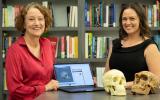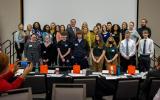Programs and Practices

The rapid pace of industry means education programs must produce skilled, job-ready graduates quickly and efficiently. This trend has prompted many community colleges to reconsider how they design and deliver technical education. At Kirkwood Community College, we use a mastery-based approach. Students advance by proving specific skills rather than sitting through a fixed number of class hours.
To make this possible, Kirkwood has combined asynchronous content and an open lab delivery model. These tools give students flexibility while continuing to hold high expectations for quality and...

Applied humanities may be the key to reversing declining enrollment trends in higher education humanities programs (Epstein, 2017; Marcus, 2025). The applied humanities situate enduring “great questions” within practical, interdisciplinary contexts, providing students with a framework to connect timeless ideas with modern challenges, promoting broad perspectives across majors, and strengthening enrollment and visibility (Atkinson, 2021). Applied humanities programs have resulted in increased humanities enrollments at some universities in the United States, with a number of institutions...

Across the globe, there is political division, civil unrest, declining trust in public institutions, and a vanishing practice of befriending neighbors. Civic discourse is more necessary than ever for building communities, and more endangered as well. In ancient times, the marketplace was where people interacted and connected. Today, many people spend more time looking at screens than faces. So, where can community members gather, listen actively, and disagree respectfully?
What follows is a brief case study of how the author, a professor at St. Louis Community College (STLCC), successfully...
In the dynamic landscape of media production, where skill and adaptability are paramount, Cuyahoga Community College's (Tri-C) Film Academy stands out as a beacon of innovation. Its six-week Film Crew Intensive Training is not just an educational offering; it is a strategic intervention designed to cultivate a cadre of immediately employable film technicians. Tri-C's model presents a compelling case study in how targeted industry-integrated training can directly address workforce needs and foster student success.
Building Local Crew: The Origins of Tri-C's Film Initiative
The genesis of Tri-C...

In July 2022, Rogue Community College’s (RCC) new President, Dr. Randy Weber, energized the college with an initiative to stabilize enrollment. This was identified as the first of five institutional priorities. Leveraging his expertise in strategic enrollment management (SEM), Weber, in collaboration with the newly appointed Dean of Enrollment Management, spearheaded a strategic shift. This transition moved the college from a narrow focus on recruitment and new students to a more comprehensive approach, embedding American Association of Collegiate Registrars and Admissions Officers SEM...

Arapahoe Community College (ACC) celebrated the completion of Phase 1 of its Health Innovation Center in October 2024 with healthcare and education partners, state and county officials, donors, civic leaders, and ACC students and employees. The Center’s simulated education spaces are used across ACC’s healthcare programs to improve functional collaboration between disciplines while preparing students to better serve patients. This expansion of healthcare programming, which began as a vision in 2017 before finally commencing in May 2023 with the renovation of ACC’s existing two-level annex...

Chandler-Gilbert Community College’s (CGCC) Title V and Enrollment Services teams offered a career exploration curriculum for ICAN youth in summer 2024. ICAN is a free, local program that provides K-12 students in Phoenix, Arizona’s East Valley with programs for educational development.
The relationship between CGCC and ICAN began in fall 2023 when the college was invited to participate in a parent information event hosted by a local school district. During this event, parents raised numerous questions about attending college, including affordability, accessibility, and admissions criteria....
Tags:

In November 2021, 16 unemployed or underemployed individuals began their journey toward bettering their lives and those of their families by becoming the first cohort to participate in Santa Fe College’s (SF) new Achieve, Conquer, Believe and Excel (ACB Excel) program. ACB Excel’s mission is to empower members of the SF community who want to break the cycle of poverty, but need the financial and emotional support to do so. The concept for this program stemmed from conversations that the college’s president, Dr. Paul Broadie II, had with community leaders regarding local economic needs and...

Critical thinking and clinical judgement of the nursing student is essential to the preparation of a competent novice nurse. Opportunities for students to practice making high-stakes decisions independently can be limited in the live clinical setting, for obvious safety reasons. Variations among local clinical placements may further limit the ability for entire cohorts to experience equitable patient cases. In addition, multiple nursing schools are competing for a limited number of clinical sites, straining programs’ abilities to meet clinical contact hour requirements. High-quality...

In 2022, Humber College launched the Bhutan Education and Skills Training (BEST) project, a five-year, $4.8 million (CND) initiative funded through the Government of Canada to support the reformation of the technical and vocational education and training (TVET) system in Bhutan’s technical training institutions. The project unites Humber College, Bhutan’s Ministry of Education and Skills Development, 10 national TVET institutions across Bhutan, the private sector, and local civil society organizations. The project is focused on building institutional capacity to support students who are often...

Mesa Community College (MCC) introduced the new Associate in Arts, Emphasis in Anthropology, in fall 2023. This is the fourth Z Degree offered by the college that is entirely online and uses open educational resources (OER), saving students time and money. Chief Online Education Officer Laura Ballard said anthropology was selected for Z Degree learning because,
The department was already offering zero-textbook-cost courses, incorporating openly licensed content, library materials, and instructor-developed content. This allowed us to focus on design and copyright when building out the degree...

Since its inception, Anne Arundel Community College’s (AACC) Model Course Program has provided over 100 faculty members with the opportunity to deepen their understanding of social hierarchy, structural inequalities, and individual-level biases and to apply diversity, equity, inclusion, antiracism, and accessibility (DEIAA) theory and praxis to their curriculum and pedagogy. The program began with a focus on highly enrolled classes, with the goal of eradicating race/ethnicity-based equity gaps in student outcomes. Each year, the program has evolved, expanded, and continuously improved based...

Environmental Science is a gateway class for environmental programs offered at Delta College. In the past, students taking this course were enrolled in the Environmental Science program. However, in fall 2022, my first semester teaching the class, students were enrolled to fulfill a general education requirement. At the end of class on day one, I began to reflect upon how to keep these students interested in a course that most of them had saved for last and dreaded taking. The development of a project that would get students excited about science and allow them to find value in the subject...

We’ve all gotten emails that attempt to gain sensitive personal information or hack into our employer’s systems. The pervasiveness of malicious hacking, including phishing campaigns, has made the need to combat such efforts a top priority for businesses across the globe. Santa Fe College (SF) is revolutionizing its security curriculum by training students in the Information Technology Education (ITE) department’s ethical hacking class to conduct phishing campaigns in collaboration with Information Technology Services (ITS). Students gain real-world experience protecting the college’s systems...

Ohio has the third largest manufacturing workforce in the United States, employing approximately 700,000 individuals (Wile, 2021). According to the Ohio Manufacturers’ Association (2022), about 17.5 percent of Ohio's gross domestic product was based on manufacturing in 2020. Intel (2022) recently announced that it will build two new microchip factories in Ohio. According to Intel (2022),
As the largest single private-sector investment in Ohio history, the initial phase of the project is expected to create 3,000 Intel jobs and 7,000 construction jobs over the course of the build, and to...

In January 2018, 14 local school district superintendents and Jackson College’s (JC) President and CEO, Dr. Daniel J. Phelan, initiated the launch of Jackson County Early College (JCEC), designed to offer students the opportunity to earn a high school diploma and an associate degree, certification, or up to 60 college credits. This article highlights the program’s successes since its first students walked through the doors in fall 2018.
Cost Effectiveness
Since the inception of JCEC, JC has reduced tuition and fees for early college students in a variety of ways. The college capped digital...

Community colleges are uniquely situated to address the nation’s need for a highly innovative, adaptable, and skilled workforce. At the federal and state levels, funding is available for design and delivery of workforce-building programs combining academic excellence, technical training, and practical experience.
Santa Fe College (SF) in Gainesville, Florida, has received a state grant to create a STEM-focused charter high school. The charter school will provide students with the tools needed to be successful in the 21st century workforce. SF’s vision is to ensure that each charter school...
March
2022
For over 100 years, the community college has been evolving as one of the most effective institutions of higher education in addressing the social and economic needs of the nation. During the 1950s and 1960s, there was general agreement that the community college was a comprehensive college designed to serve the multiple needs of a diverse student body through a variety of programs, including developmental, transfer, vocational, general, and community education. In the past few decades, that purpose has been changing as the developmental, general, and community education programs have been...
October
2021
College students who are parents, a.k.a., student-parents, have always been enrolled in community colleges, but only within the past few years have they been explicitly recognized as a distinct student group with a unique set of support needs. According to the Institute for Women’s Policy Research (2018), more than one in five postsecondary students in the U.S. is a student-parent. This holds true at Monroe Community College (MCC), where 21.4 percent of students enrolled in 2019-2020 had children under age 18 (DeMario, 2021).
Student-Parent Risk Factors
Figure 1 shows that MCC’s student-...
Tags:

The level of alumni engagement at two-year colleges is well below that which is typically found at four-year institutions (Magaw, 2013; Skari, 2013; Theis, 2018). This is an issue that affects community colleges’ bottom line, the experience of currently enrolled students, and the connection between alumni and their institutions.
The lack of alumni engagement at two-year institutions is often the result of misconceptions about alumni loyalty (Skari, 2013). Those working in alumni engagement at the two-year college level have undoubtedly heard excuses for why their institution cannot dedicate...










